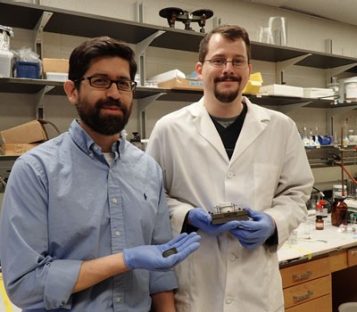Maldonado Lab: Cheaper, greener way to grow cystalline semiconductor films
Device to simultaneously synthesize and deposit crystalline semiconductor films from water at room temperatures
University of Michigan chemists have developed a greener, cheaper way to make single-crystalline semiconductor films, components at the heart of all of our electric gadgetry.
Single-crystalline films of inorganic semiconductors are the bedrock of nearly all electronics, including smartphones, computers and solar panels. The fastest integrated circuits feature transistors consisting of germanium films on silicon. But such materials are typically only prepared at elevated temperatures, with complex machinery that involve hazardous gases.
The UM team, led by Stephen Maldonado, an associate professor of chemistry, has invented a method to simultaneously synthesize and deposit crystalline semiconductor films from water at room temperatures using equipment that can be assembled for just a few dollars.
"Our method doesn't require excess heat, and everything is done in an aqueous solution so we're not using any toxic precursors," Maldonado said. "And we're doing this without sacrificing any quality in the crystallinity of the material, which is usually the trade-off."

To do this, Maldonado and his team make a thin, liquid metal film that rests on a substrate that they connect to a power supply. When they electrify the metal film, molecules on the surface of that film—if they're in contact with water—can be reduced into their elemental parts. In this case, units of dissolved germanium oxide are transformed into germanium atoms that dissolve into the liquid metal film.
"If the liquid metal film is thin enough, the germanium atoms will precipitate out, but selectively at the bottom and
as a uniform crystalline film." Maldonado said. "The cool thing about this is we're taking an oxidized precursor—like what you'd find in nature—and in one process step, we can produce a technologically relevant film that is one large contiguous crystal."
Maldonado said his team's next steps will be to do the same process with silicon. The chemistry is more nuanced but the principle is the same.
Ultimately, without complex machinery and high temperatures, Maldonado's process could provide a cheaper, greener way to produce semiconductors.
"There's a reason why everyone on the face of this planet doesn't have access to advanced electronics," Maldonado said. "Making high performance semiconductor devices requires a substantial infrastructure."
"This process, in terms of the key elements of it—we're talking about stuff you can get at RadioShack. You don't need high temperature, you don't need elaborate machinery. You just need a means to draw and measure a current, but the electronics you could literally put together for $20. This work is a step towards a semiconductor manufacturing industry that could be run by anyone, anywhere."
The team's research is published in the Journal of the American Chemical Society:
--Morgan Sherburne, UM News

